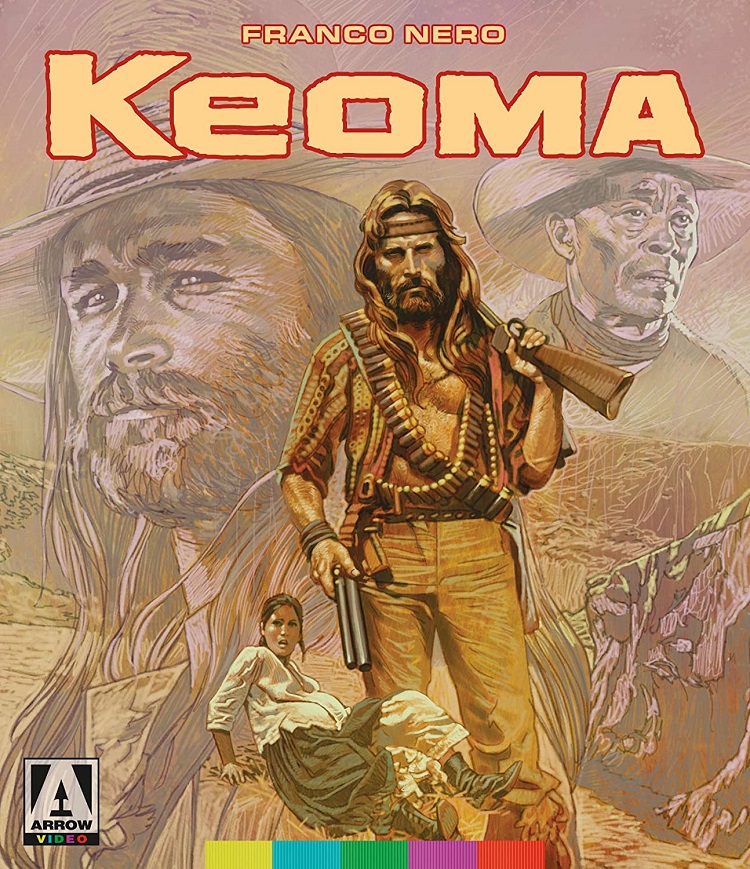
With his Dollars trilogy, Sergio Leone revived the failing western genre, infused it with European sensibilities, and created his own subgenre, the Spaghetti Western. With their scruffy, loner heroes, off-kilter visual design, and unusual scores, Leone’s films gave the western a new and distinctive style. Their worldwide success created a numerous imitators, some more successful than others. By 1970, the genre had slipped into parody or outright slapstick. By 1976 it had all but died out. With Keomo, director Enzo G. Castellari along with star Fraco Nero gave it one last gasp, but by then we had all moved on.
Buy Keoma Blu-rayNero (sporting a long-haired wig and beard that makes him look a lot like Jared Leto in rock-star mode) stars as the titular Keoma, half-white/half-Indian, who was adopted by a wealthy ranch owner and notorious gunman named William H. Shannon (William Berger) much to the disappointment of his three real sons who think good old dad dotes on Keoma whilst ignoring them. Keoma fought for the North in the Civil War and returns home only to find it decimated by the plague and taken over by a corrupt ex-Confederate soldier named Caldwell (Donald O’Brien). The brothers have joined up with Caldwell and immediately look upon Keoma with suspicion.
On his way into town, Keoma sees some of Caldwell’s soldiers taking a group of plague-ridden people to a secluded camp where they will be forced to live out whatever days they have left as defacto prisoners. One of these prisoners is a pregnant widow (Liza Farrow) who isn’t showing any symptoms of the plague but is being dragged off to die anyways. Keoma rescues her and takes her back to town where he rents her a room at the local brothel, shooting anyone who tries to stop him. Caldwell gets word of this betrayal and vows to stop Keoma. What follows is a series of pistol-packing, knife-throwing, rifle-blasting action sequences filled with endless style, a non-stop onslaught of slow-motion deaths and some of the worst music ever put on celluloid.
In between the action is a lot of boring nonsense about family and finding yourself and long, longing looks into the horizon. Keoma is an odd pastiche of varying western genres – classic, spaghetti, and more modern American films like the Wild Bunch – that’s filled with style but never quite comes together.
There are some really nice visual scenes like one that is filmed behind a target that slowly reveals the characters standing in front of it as they blow bullet holes into it. Or another in which the camera holds in close on Keoma’s four fingers, revealing the men he’s about to kill as he counts, dropping one finger at a time. But there are also long stretches where very little happens and we are treated to some really terrible singers recounting the action we just watched. Put together it is a film well worth watching, but one that falls a bit short of being a classic in the genre.
Arrow Video has given it a new 2K transfer from the original 35mm negative. It has an aspect ratio of 2.35:1 aspect ratio, and it features an uncompressed mono 1.0 LPCM audio track. It comes with both Italian and English language tracks (though annoyingly the English track doesn’t come with English subtitles). Extras include audio commentary by spaghetti western experts C. Courtney Joyner and Henry C. Parks. There are new interviews with Franco Nero, Enzo G. Castellari, actors Luigi Montefiori, Massimo Vanni, Volfango Soldati, and editor Gianfranco Amicucci. Also included is a new video appreciation from Austin Fisher plus an intro from Alex Cost and the usual trailers, promo images, and a full-color booklet with an essay from Simon Abrams and Howard Hughes.
Keoma was released just as the Spaghetti Western was dying. Is isn’t a good enough film to have resuscitated it, but it makes for a very nice closer to any retrospective of the genre. Arrow Video has done their usual fantastic job of restoring the film and providing lots of extras to give a full understanding behind the making of the film and its place in film history.